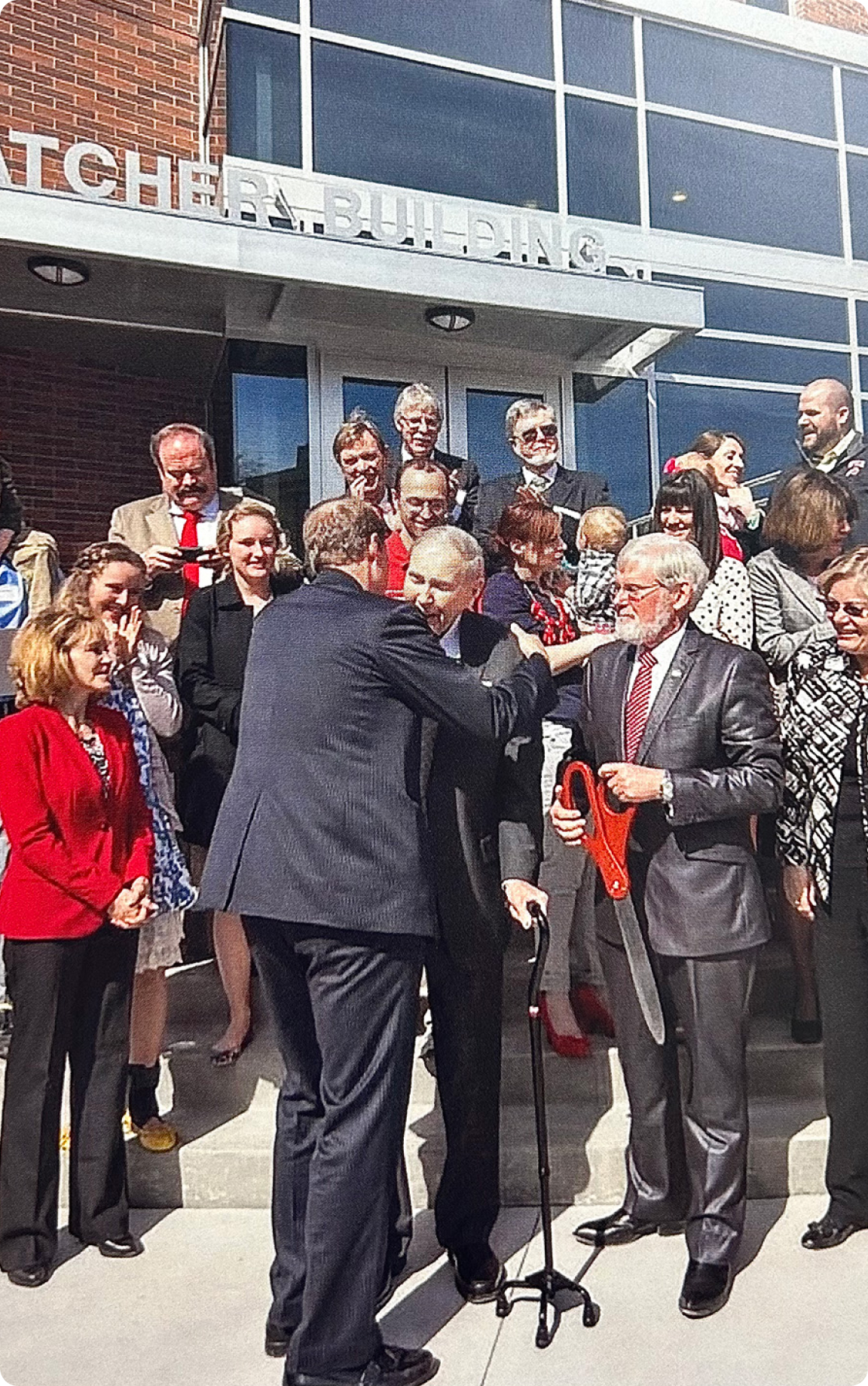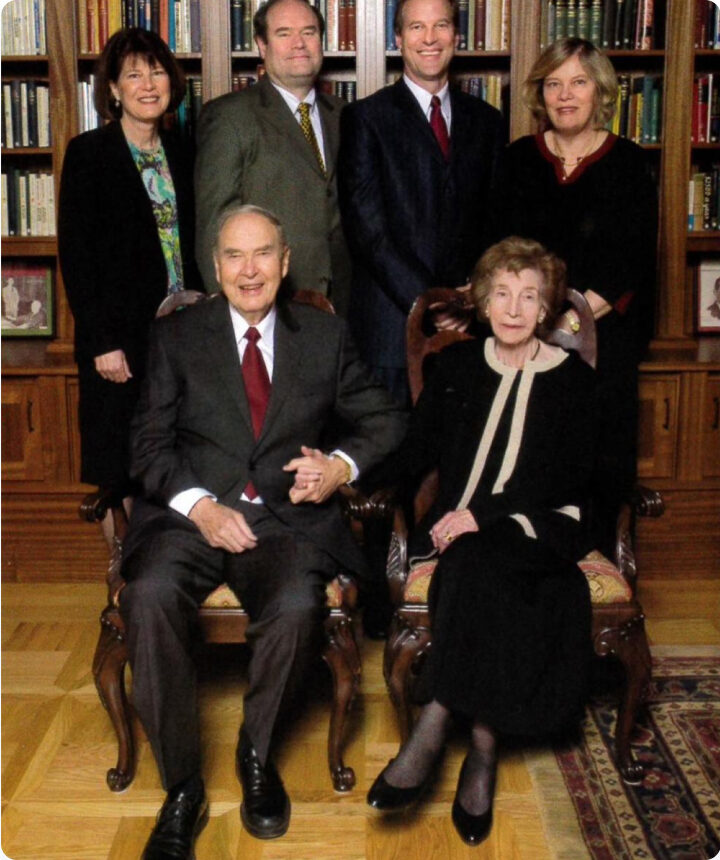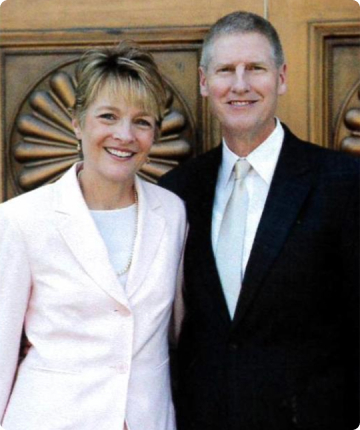The Thatcher Building for Biological and Biophysical Chemistry was dedicated on Wednesday, March 13, 2013. It has been a creative force, paving the way for new opportunities for innovation, education, and research. In this space, the Department of Chemistry has been able to:
- Educate more undergraduates, mentor the next generation of critical thinkers, and train them for careers in chemistry.
- Recruit star faculty, opening new scientific inquiries and new markets for chemistry-driven innovation in industry.
- Acquire advanced research instruments, and probe solutions in bioenergy, epidemiology, and small molecule development.
- Leverage building space to grow community and philanthropic support for chemistry research and education at the U.
These accomplishments have led to significant growth in the Department's standing and research, and we anticipate that student enrollment will grow by 30% or more over the next decade. To answer this growth, the Thatcher Building will allow us to:
- Educate. Teach the next generation of scientists, business leaders, and innovators, for whom chemical principles will be key to success and prosperity.
- Innovate. Create jobs and economic growth in Utah by supporting student enrollment and new, interdisciplinary research collaborations.
- Impact. Advance chemistry as the central science, increasing its prominence at the University of Utah and driving chemical solutions to problems in related fields.
- Better Humanity. Lead the way in research that creates solutions for global health, renewable energy, and age-related diseases.
In these ways, the Thatcher Building of Biological and Biophysical Chemistry will significantly extend the resources available to professional and aspiring chemists, and enhance the ability of the Department to recruit faculty and conduct research at the University of Utah.

The Thatcher Building for Biological and Biophysical Chemistry provides a modern home for teaching and research in the Department of Chemistry. The facility houses cutting-edge research labs that provide the critical space needed for collaboration to develop into innovative research. These efforts will attack important problems in science with particular emphasis on the field of biological chemistry that will inspire advances in medicine. The National Institutes of Health recognized the importance of this work when it awarded an $8 million grant to help construct the building. The discoveries to be made in the Thatcher Building will improve the health and quality of life for the people of Utah and around the globe.
This new home for the Department of Chemistry will be the place where students become scientists, medical doctors, and entrepreneurs. With breathtaking views of the Salt Lake Valley, top-floor seminar rooms provide a place for discoveries in science to be discussed, shared, and realized.
The Chemistry Department at the University of Utah is recognized worldwide for great strides being made in conducting research to uncover the causes of cancer and other diseases, enhancing systems for drug delivery, developing treatments for the ills of aging, and otherwise helping to improve the human condition. Our family is honored to play a part in making this building a reality, and we hope you'll join us to help advance chemistry research, power the economic engine for our state and region, and educate chemists and scientists that serve society.
Wednesday, March 13, 2013
The University of Utah
Henry S. White - Chair of the Department of Chemistry
- David W. Pershing - President of the University of Utah
- Pierre V. Sokolsky - Dean of the College of Science
- Henry S. White
- Thomas F. Thatcher - Thatcher Family Spokesperson
- Natscha K. Knowlton - Thatcher Company Scholarship Recipient
Henry S. White
Throughout the entire building, numerous gathering spaces provide informal venues to share and develop scientific ideas. The entire second floor is dedicated to teaching laboratories and advanced instrumentation. These labs will serve a growing number of chemistry and biological chemistry students who will have hands-on access to modern spectroscopic equipment for elucidating the structure and function of molecules. The open design of the building provides a window into the process of science as facilities for teaching and research are integrated. The potential of this new home for Chemistry is unlimited.
The Curie Club Active Learning Center on the 2nd floor of the Thatcher Building will host activities ranging from advanced undergraduate experiments in the adjacent laboratories to informal outreach to school children and scout groups.
Established in 2011, one hundred years after Marie Curie's Nobel Prize in Chemistry, the Curie Club is comprised of passionate, successful, civic-minded, and intellectually engaged members of the community to help overcome barriers, celebrate the accomplishments of women scientists and encourage more young women to pursue a life of the mind.
"Nothing in life is to be feared, it is only to be understood."

The Thatcher family's involvement in the chemical industry stretches back to the early 1900s, and their connection to the U goes back nearly as far. Family patriarch, Nathan D. "Dee" Thatcher, Jr. co-founded Wasatch Chemical Company in Salt Lake City, becoming a major chemical producer and distributor. Along the way, Dee's two sons, Winston (BA 1943, chemistry) and Lawrence(BS 1945, chemical engineering) joined the company. Winston's wife, Lucille, and Lawrence's wife Helen, are likewise U alumni, both in education. After Dee's retirement, Winston and Lawrence carried on but ultimately left the company. Then, in 1967, Lawrence founded Thatcher Chemical, later renamed The Thatcher Company.
Lawrence and Helen have four children: Diane T. Barlow, Craig N. Thatcher, Teri H. Flanders, and Thomas F. Thatcher. Craig and Tom graduated in chemistry from the U, and went on to get MBAs-Craig's from Northwestern, and Tom's from BYU. Diane and Teri followed their mother's lead: each holds a degree in education from the U, and Diane also has an Ed from BYU. Tom currently serves on the College of Science Advisory Board.
In grateful recognition of the accomplishments of this remarkable family and their outstanding service and support of the College of Science, including a multi-million-dollar gift toward the expansion of the chemistry facilities, the University of Utah Board of Trustees approved recognizing this family by naming the new structure the Thatcher Building.

The university is pleased to recognize Don and Rebecca Reese for their contributions to the new Thatcher Building. To enhance the training of undergraduate students on the latest techniques and tools in chemistry research, Dr. Don L. Reese and his wife, Rebecca, have made a major contribution to the Thatcher Building. In recognition of their support, the second-floor labs will be named the Don L. Reese Advanced Undergraduate Teaching Laboratories. The Don and Rebecca Reese Chemistry Reception Area adjacent to the Chemistry Seminar room is also named in recognition of their support.
Don received his bachelor's degree in chemistry in 1973, and his M.D. in 1977, both from the U. Rebecca is also a U alum. Both have been generous supporters of the College of Science For more than 20 years. In addition to the contribution to the new Thatcher Building, the couple established an endowed scholarship for science and math teaching in 2007.
Lawrence E. & Helen F. Thatcher Family
Don L. & Rebecca E. Reese
Alliant Techsystems, Inc.
Peter B. Armentrout & Mary Ann White Terrell N.& Virginia L. Andersen
Jeffrey L. & Kathleen T. Anderson Karen L. Anderson
Zlatko Bacic
Chett J.& Shannon Boxley Rodney H.& Carolyn H. Brady Don R. & Catherine M. Brown Joseph F. Brown
Cynthia J. Burrows & Scott L. Anderson
Chevron Humankind Matching Gift Program
Daryl P. & Lydia R. Cobranchi
Cynthia Conner & Igor Best-Devereux
Margaret DeAngelis & Michael Feehan Larry A Donoso
Norman J. Dovichi
Jeffrey D. & Jane E. Driggs
Dan B. and Nathania S. Elder
Eli Lilly and Company Foundation
Edward M. & Marilyn M. Eyring
Julius C. Fister
Dean & Teri H. Flanders
Stephen C. & Pamela T. Flanders
Mark A. & Dianne C. Flanders
Carla M.& Peter F. Flynn
Regina Frey & William Buhro
Jean & Anne Futrell
Bridget L. Gourley
David C. Hanley
Frances N. Harris & Joel M. Harris
Kenneth Hartner
Gale A.& John
L. Haslam
Hans J.& Charlene Holland
Hua Huang & Minmin Lin
Jeffrey R. & Angela Jacobsen
William E. Jack
Richard A. Jackson
William B. Lacy
Christine Lake & Heber S. Jacobsen
John W. Kenney, Ill
Carol Korzeniewski
Linda M. & Craig V. Lee
Vivian S. Lee & Benedict Kingsbury
Jan & Gunnel Underberg
Claudia Skaggs Luttrell
Jeanne L. McHale & Fritz J. Knorr
Christopher S.& Janette Meldrum
Shelley D. Minteer & Robert Churchwell
John R. Morrey & Barbara Mortensen Morrey
The National Institutes of Health
Ruth L. & Phillip J. Novak
Dinesh & Kalpana Patel
Eric M. Peterson
Pete E. Poston
Susan R. & C. Dale Poulter
Ronald & Eileen Ragsdale
Kirk M. Ririe & Mary Jane O'Connor
Jack W. & Gae S. Rose
Jonathan M. Rubin
Michael C. & Sarah W. Scheuller
Ronnie Lee Shepard
Yanlong Shi & Lian Shao
Scott & Marcia F. Stornetta
Kathlyn &Thomas F. Thatcher
James C.Tou
Rory "Ziggy" Uibel
Jacob T. & Erin L. Umbriaco
Waters Corporation
Michael R. & Jan Weaver
Lisa A. Wenzler & Kenneth A Savin
Henry S. White & Joyce Garcia
Charles A. Wight & Victoria Rasmussen
Pearl Wright
Yaping Xu
